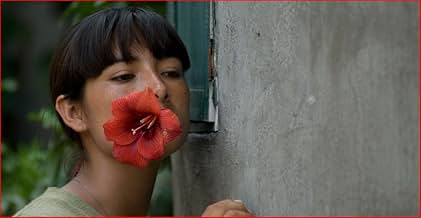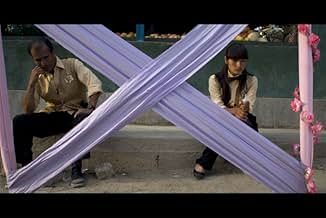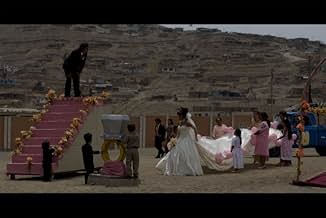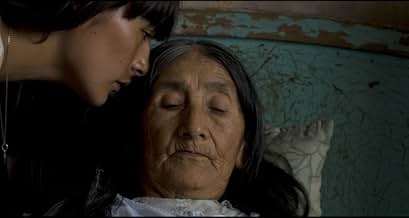La teta asustada
- 2009
- 1h 35m
Ajouter une intrigue dans votre langueFausta is suffering from a rare disease called the Milk of Sorrow, which is transmitted through the breast milk of pregnant women who were abused or raped during or soon after pregnancy. Whi... Tout lireFausta is suffering from a rare disease called the Milk of Sorrow, which is transmitted through the breast milk of pregnant women who were abused or raped during or soon after pregnancy. While living in constant fear and confusion due to this disease, she must face the sudden dea... Tout lireFausta is suffering from a rare disease called the Milk of Sorrow, which is transmitted through the breast milk of pregnant women who were abused or raped during or soon after pregnancy. While living in constant fear and confusion due to this disease, she must face the sudden death of her mother. She chooses to take drastic measures to not follow in her mother's foots... Tout lire
- Nommé pour 1 oscar
- 16 victoires et 6 nominations au total
Avis en vedette
The pacing might seem awkward, some twists in the story line and/or character arc, might not be accessible to some viewers, but all those things make the movie even better. At least that's how I see it. Still as this is a movie that provokes or encourages you to think a lot, there might come up a few questions, story-wise and or character-wise that might leave you with a slightly bad taste.
And although up until now the review the user GeneralGrievous gave hasn't received positive feedback, you have to cut the guy some slack. If you read his review, you can understand why he didn't like the movie quite as much. I thought his review was helpful, even though I don't agree on everything he writes, because he explains not only why he thinks that way, but he gives a few glimpses into his knowledge of Peruvian film-making.
Though the plot itself may seem awkward, the movie is a group of 95 minutes rich and beautiful images. The pearls, the potato, the dog, the wedding, the impoverished suburban Lima, everything is accurately directed and carefully thought by Ms. Llosa.
Fausta (outstanding Magaly Solier) is suffering from The frightened tit, an illness that she caught through her mother's breast-milk since her pregnancy happened during the 1980s and 90s terrorism and State violence in the Andes. Now in Lima, Fausta is afraid, she's put a potato in her vagina in order to protect her from being raped, and after her mother dies she finally has to deal with the real life and face her fears,starting to work in a high- class house as a made.
The plot of the movie is fictitious, but it lies on a cruel and past reality of Peru's modern history, combining it with a delicate halo of surrealism, magic realism and sometimes ironic humor. The image of the potato -all time Peruvian ingredient for cuisine- involves the subject of a war and a fear that affected an entire country, though our differences may not accept it yet. The scenes in Fausta's home are the opposite where she works: though the high-class house is in the same impoverished area (another reference to Peruvian social differences), over there is no gray, no dust: there are plants, color, life.
At the end, Fausta realizes that in the root of her fears is the solution of them. The movie, indeed, is presented as a cure for the unhealed wounds of a terrible and recent war that happened on Peruvian soil.
Mastery at low-budget cinematic skill should be credited to Bollywood (the Mumbai-based Hindi language film industry) films, which may not be the most groundbreaking in technical or screen writing terms, but contain music in the form of song-and-dance numbers woven into the script in order to appeal to all segments of the audience and maximise box office receipts. Since Hollywood's multi-million budgets would never have helped shoot realistic and colourful, but rough Brazilian imagery, 'Central Station' (1998) and 'Cidade de Deus' (2002) garnered indisputable acclaim at renowned film festivals after being funded on their own. The example set by off-Hollywood movie makers' efforts have become heroic in countries where movie industry budgets are, to say the least, scarce.
This is the case for LTA. It could have been more on par to Danny Boyle's 'Slumdog Millionaire' if it wasn't for the Peruvian-Spanish meagre budget available to Peruvian young director Claudia Llosa. If you expect to see acting beaus or beautés, famous screenwriters and crew, expensive car explosions or CGI, go elsewhere. LTA is neat magic-realism, a territory where people may be poor but not disgusting, where their houses are mere recreation centres for fantasy and everyday life to play happily together. Only time will tell if the trend keeps up, spreads globally, and ends up being called Globbywood.
This is a well-told tale of hope where only two professional actors are involved. And this was as clear to Berlinale judges as it is for the general public -those with a thirst for veritable, honest, witty craftsmanship at film-making.
Le saviez-vous
- AnecdotesMagaly Solier used to sell Puca picante (Andean treat) in the street before she was discovered by Claudia Llosa in 2005 while looking for extras for Madeinusa (her first film). Now she's a recognized actress and talented singer.
- ConnexionsFeatured in Brief Film Reviews: The Milk of Sorrow (2010)
- Bandes originalesQuizás algún día
Music by Magaly Solier
Lyrics by Claudia Llosa
Performed by Magaly Solier and Bárbara Lazón
Meilleurs choix
- How long is The Milk of Sorrow?Propulsé par Alexa
Détails
- Date de sortie
- Pays d’origine
- Sites officiels
- Langues
- Aussi connu sous le nom de
- The Milk of Sorrow
- Lieux de tournage
- sociétés de production
- Consultez plus de crédits d'entreprise sur IMDbPro
Box-office
- Brut – États-Unis et Canada
- 10 462 $ US
- Fin de semaine d'ouverture – États-Unis et Canada
- 1 914 $ US
- 29 août 2010
- Brut – à l'échelle mondiale
- 1 557 750 $ US
- Durée1 heure 35 minutes
- Couleur
- Mixage
- Rapport de forme
- 1.85 : 1
Contribuer à cette page











